

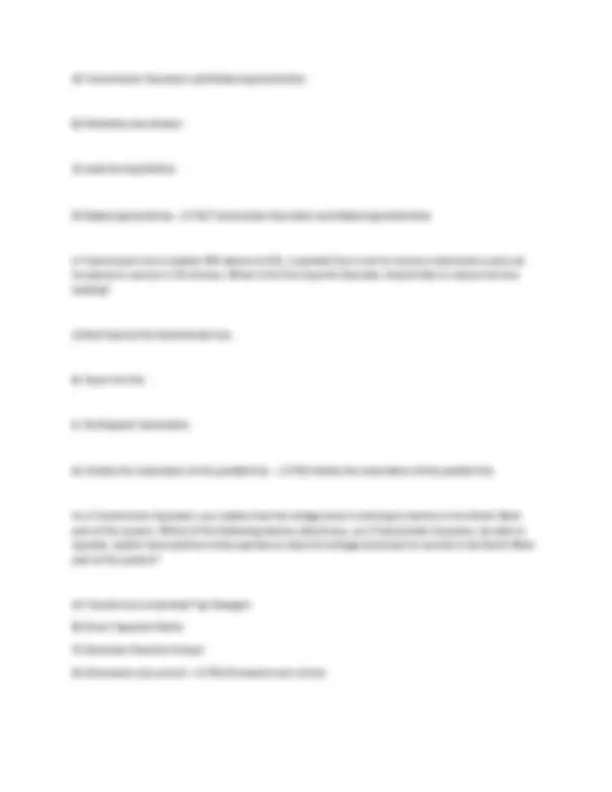
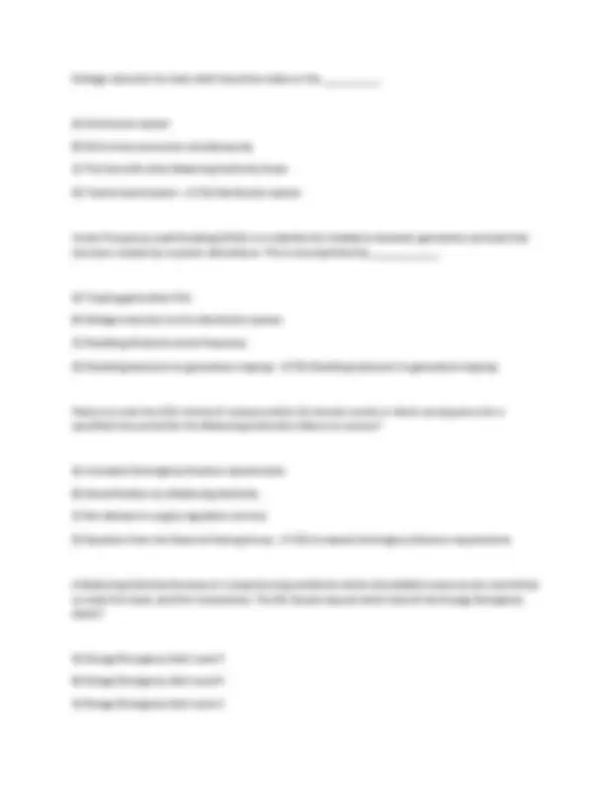
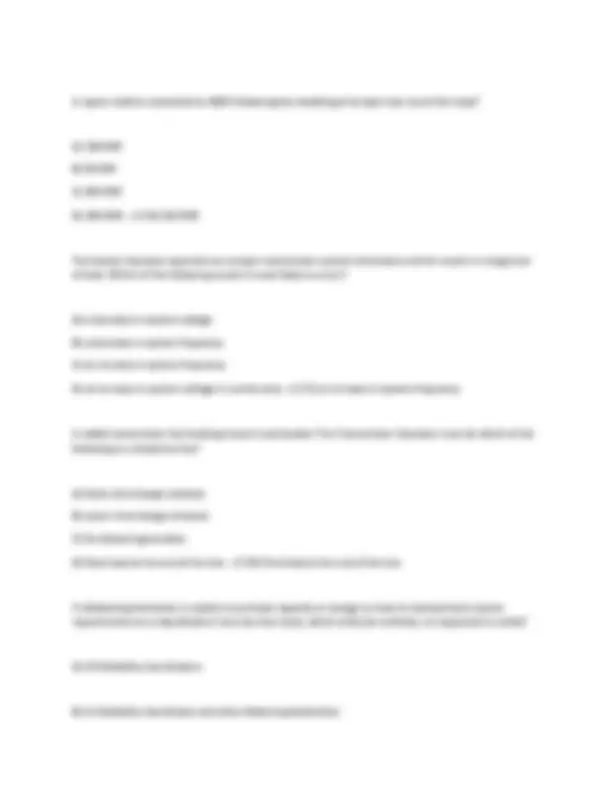
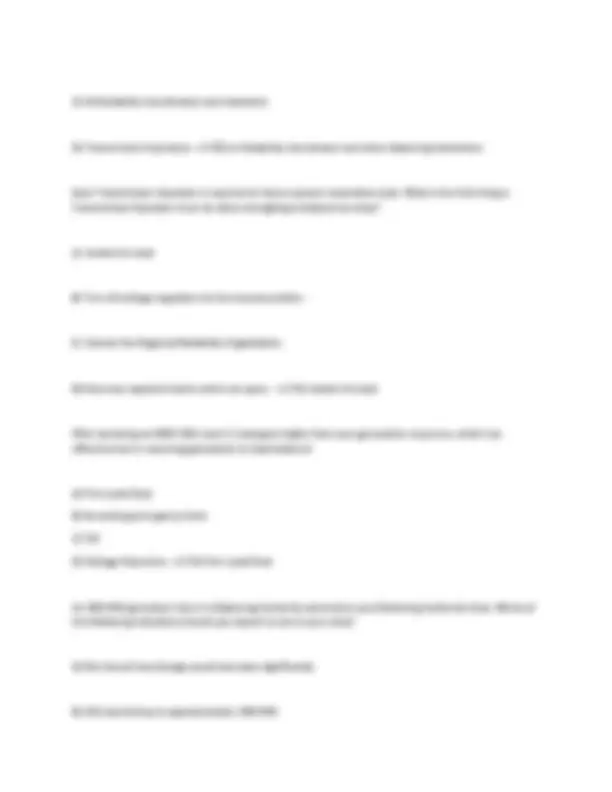
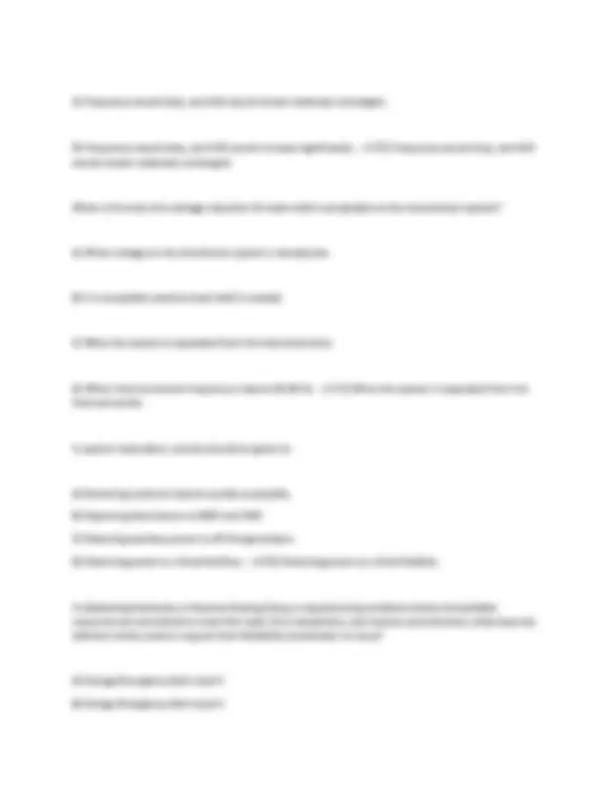
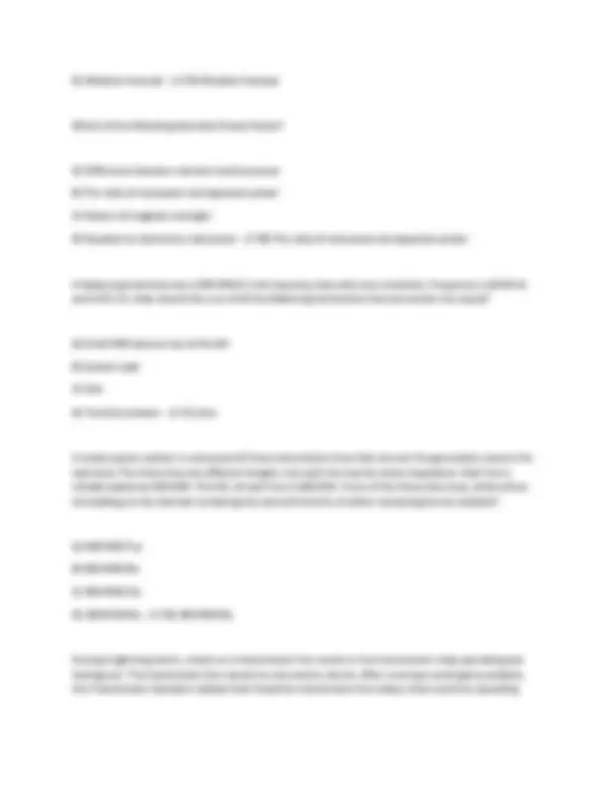
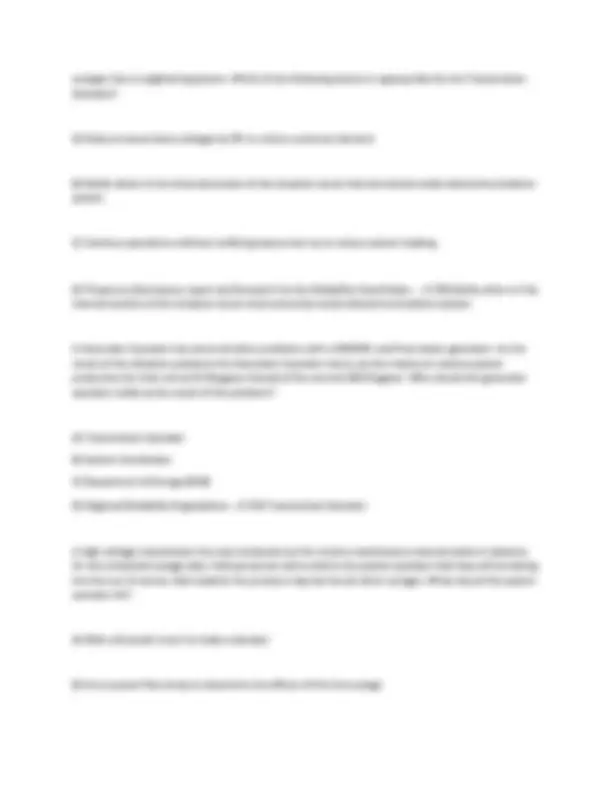
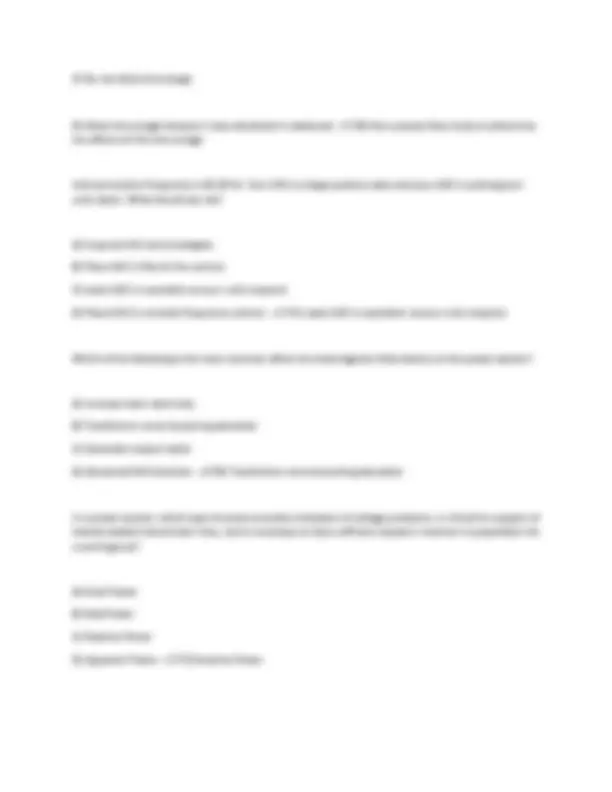
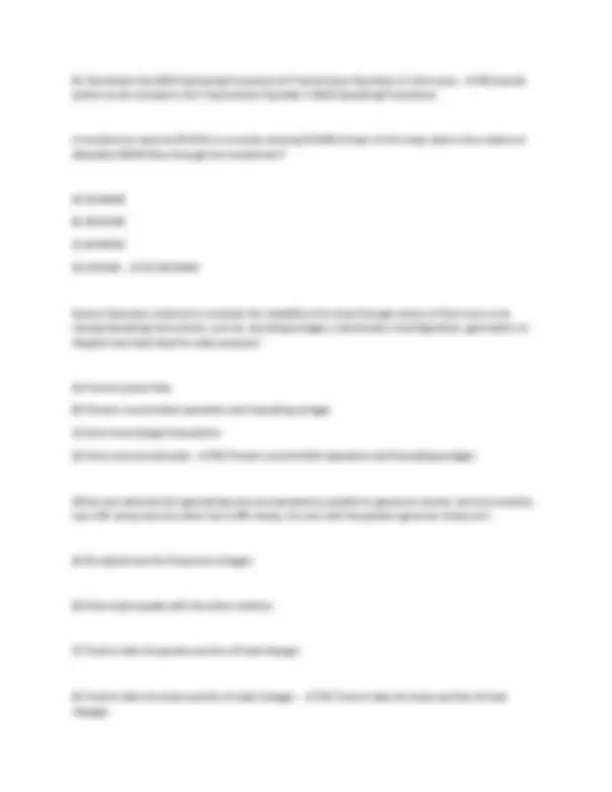
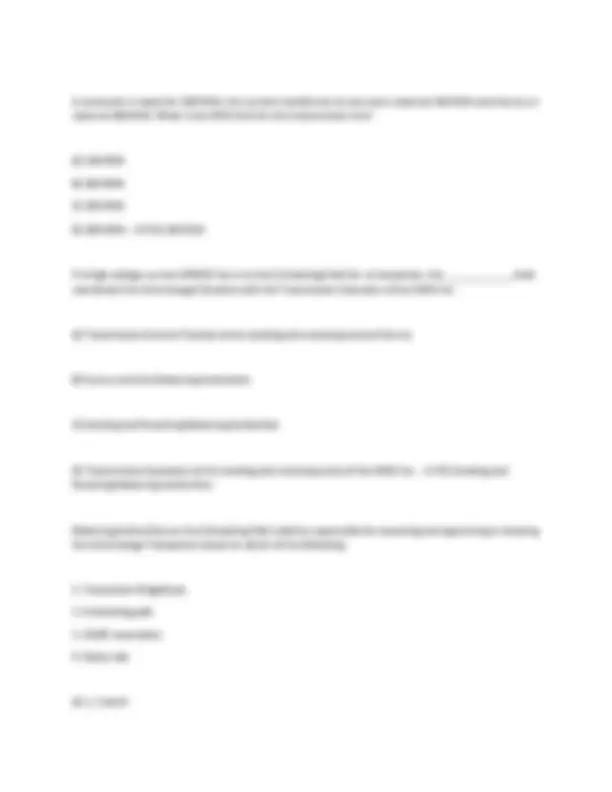
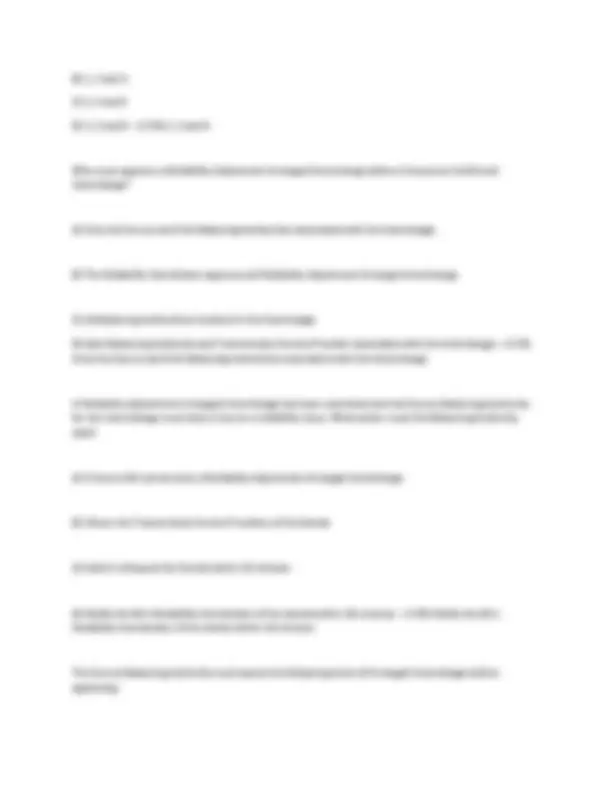
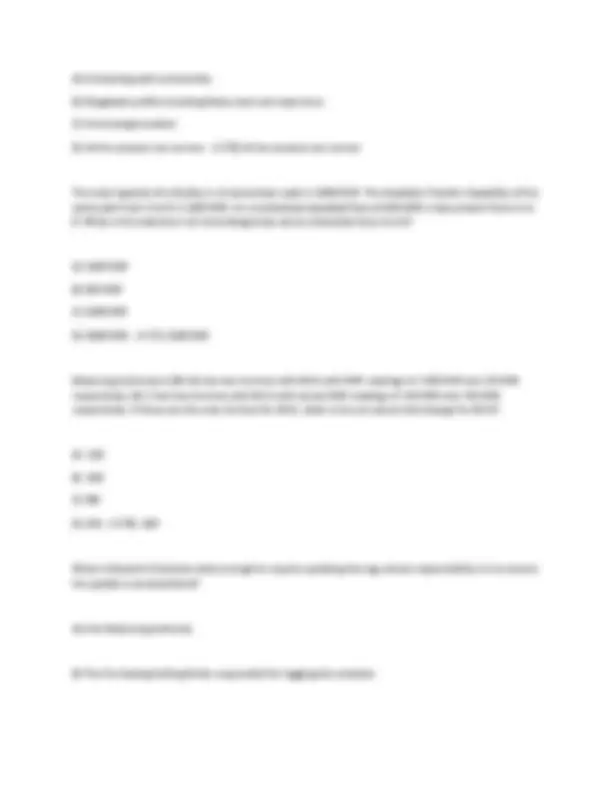

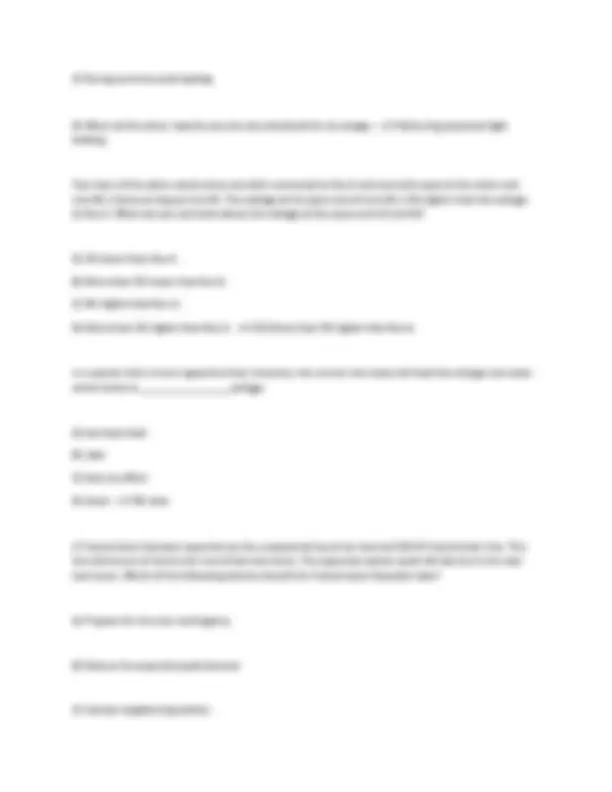

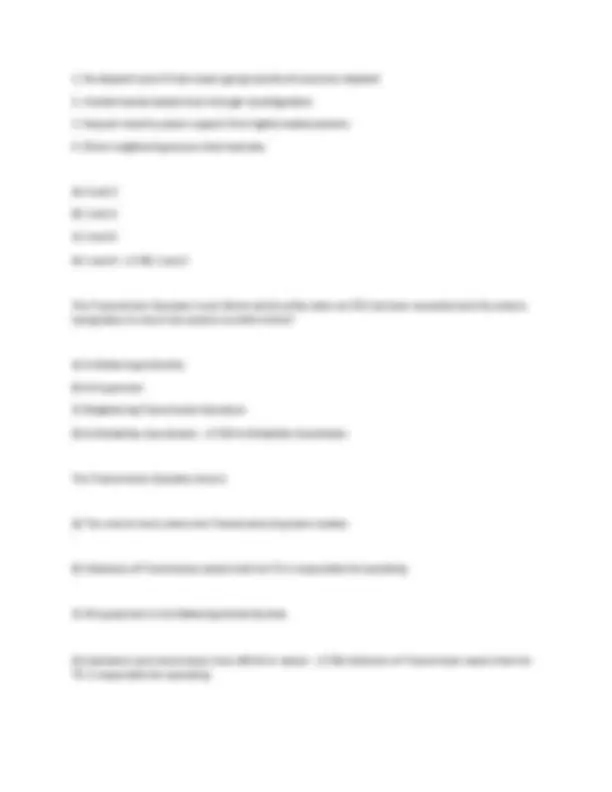

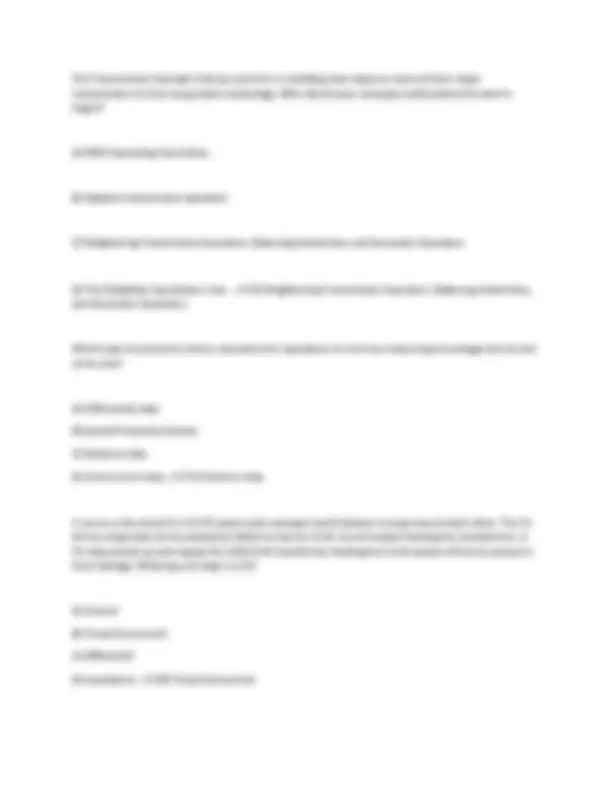
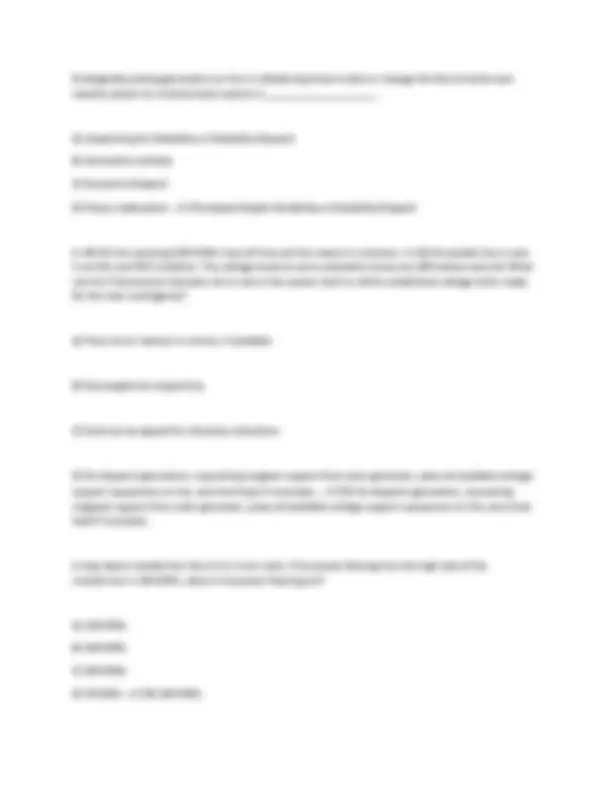
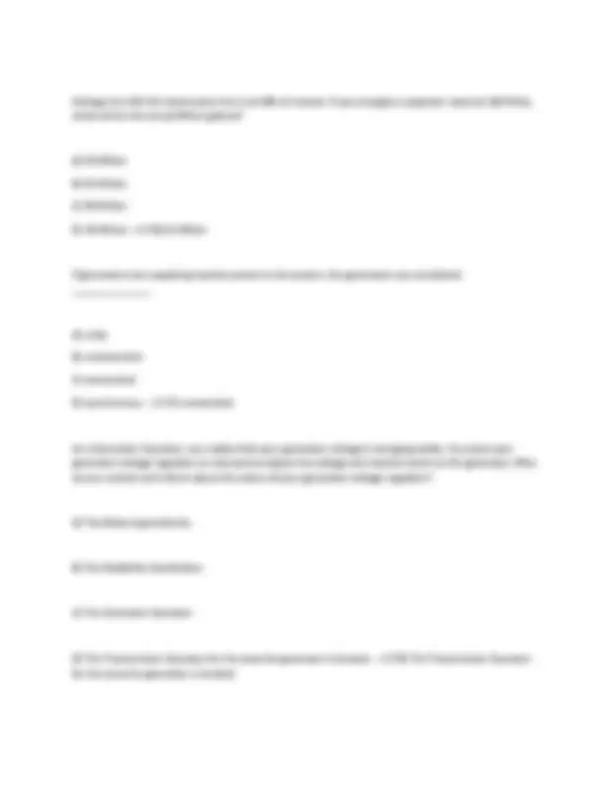
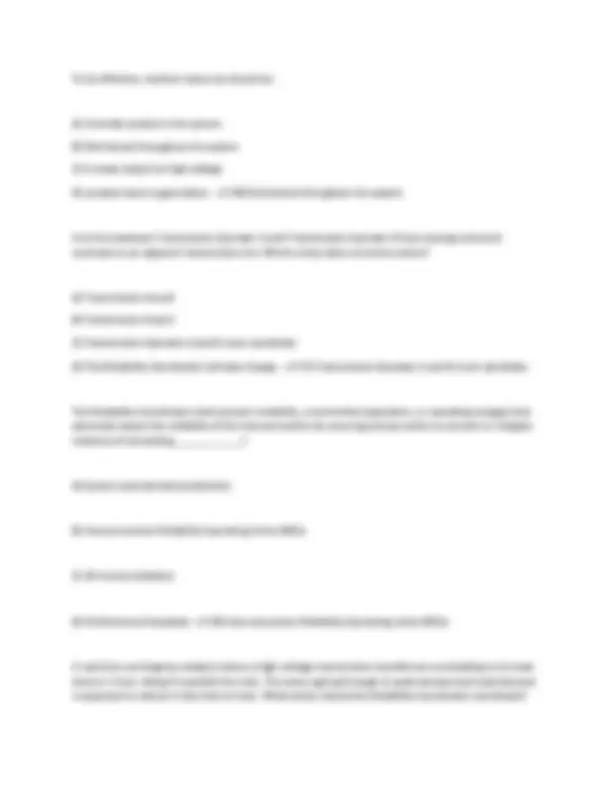
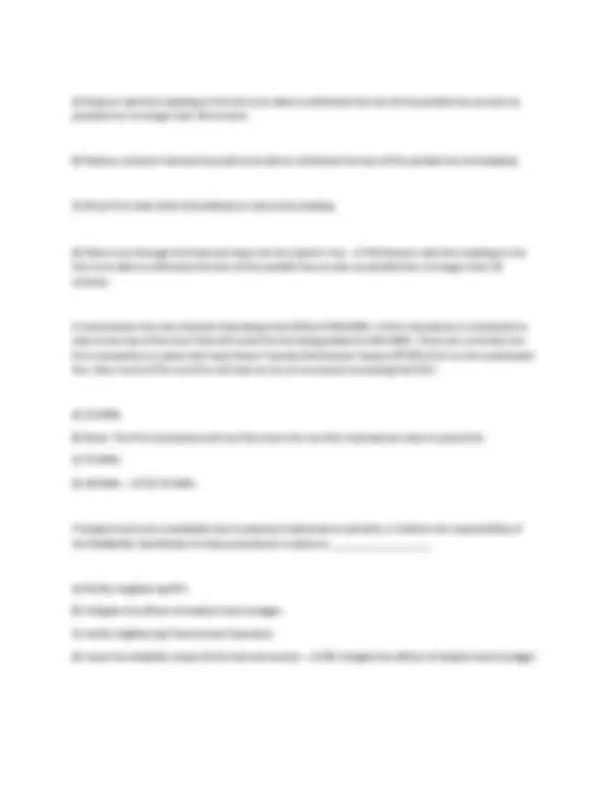
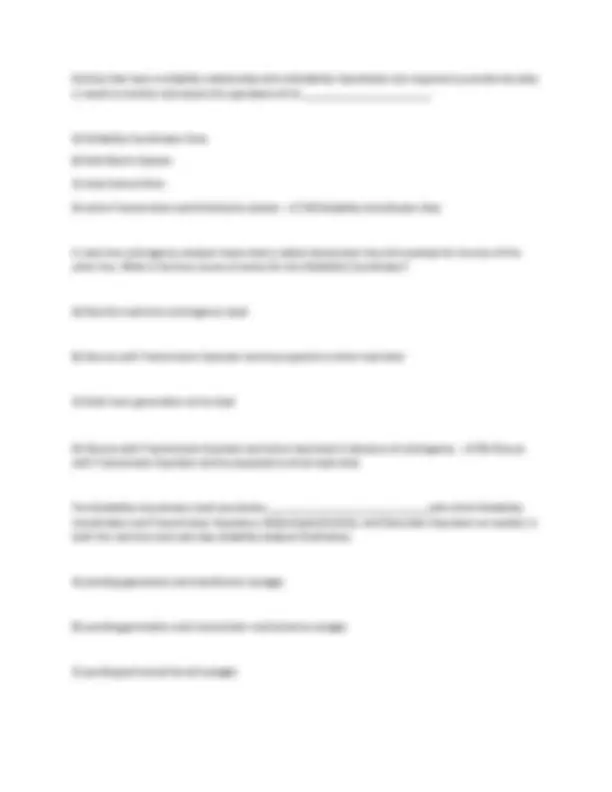


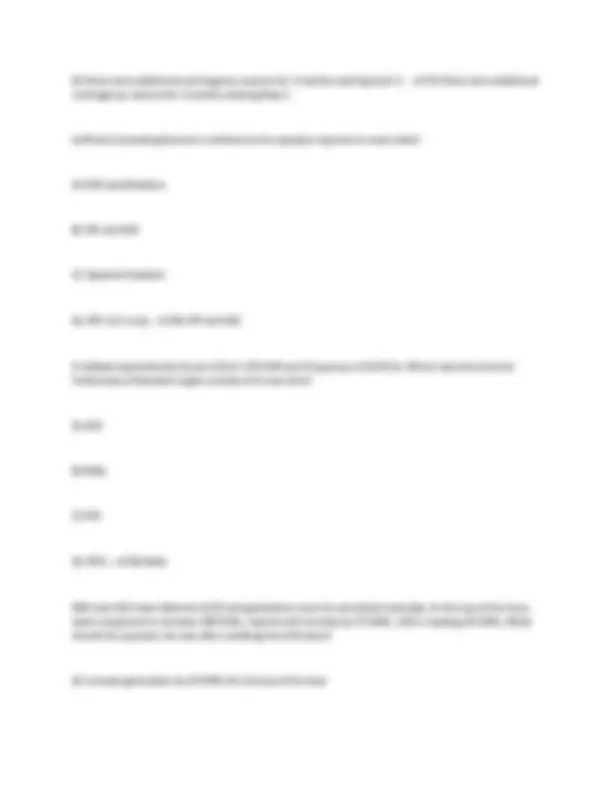










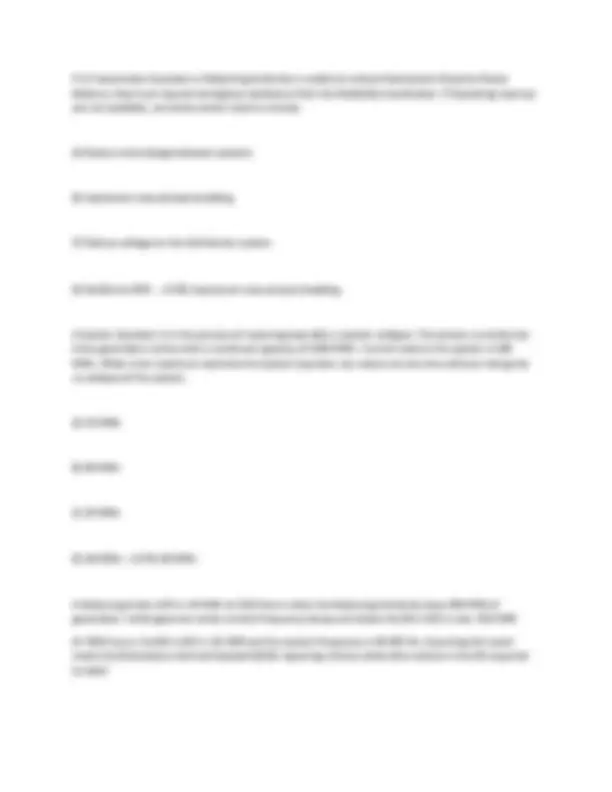


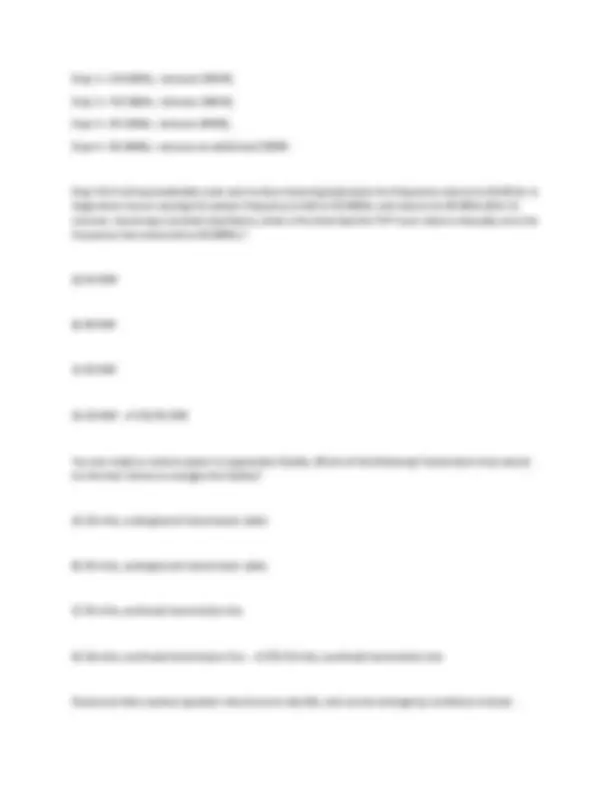














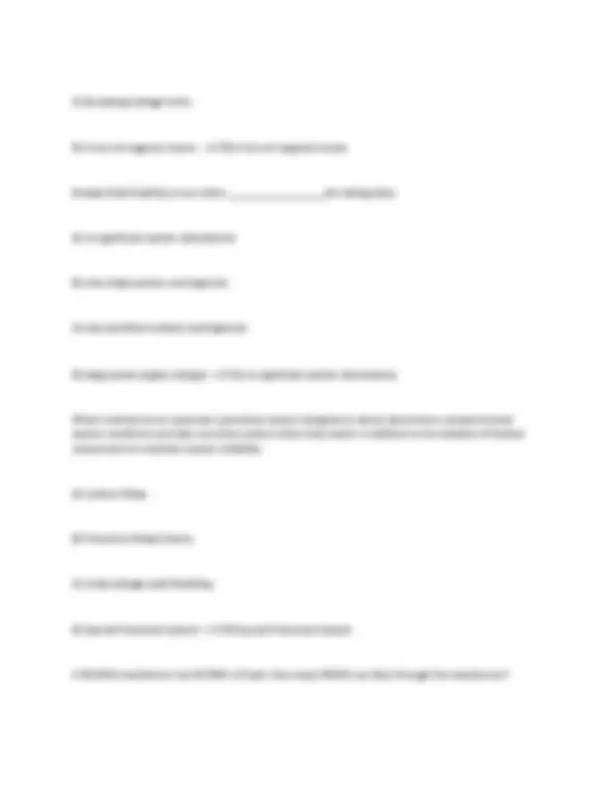



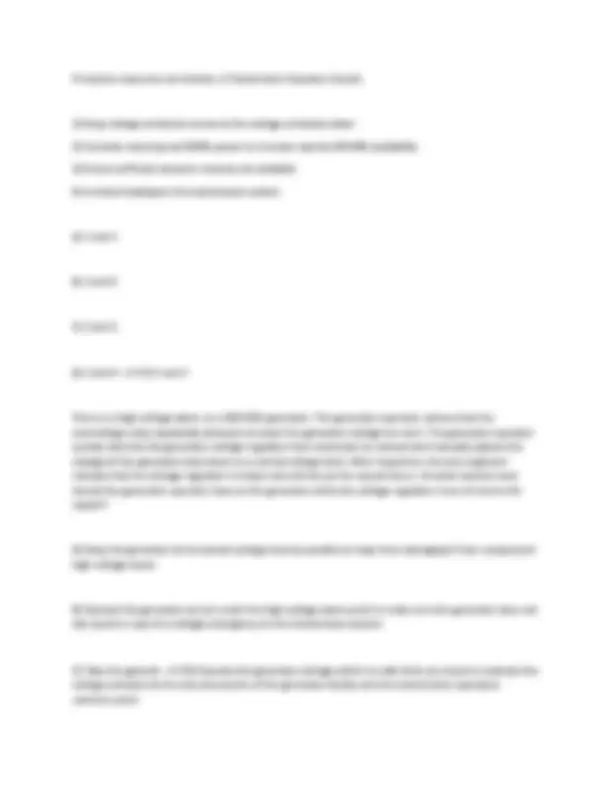




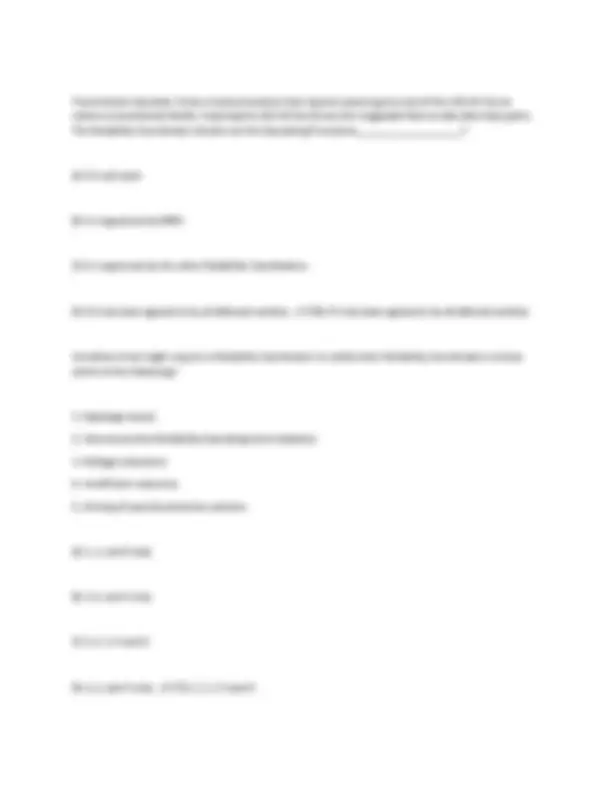




Study with the several resources on Docsity

Earn points by helping other students or get them with a premium plan


Prepare for your exams
Study with the several resources on Docsity

Earn points to download
Earn points by helping other students or get them with a premium plan
Community
Ask the community for help and clear up your study doubts
Discover the best universities in your country according to Docsity users
Free resources
Download our free guides on studying techniques, anxiety management strategies, and thesis advice from Docsity tutors
The Reliability Coordinator just informed you of a slow time error correction which will begin at the top of the next hour. Your EMS system will not let you change your scheduled frequency. Your Frequency Bias Setting is -100 MW/.1Hz. What action should you take? A) Increase Net Interchange Schedule by 20 MWs. B) Inform the Reliability Coordinator that you cannot participate in the time error correction. C) Decrease Net Interchange Schedule by 20 MWs. D) Increase Net Interchange Schedule by 10 MWs. - ✔✔A) Increase Net Interchange Schedule by 20 MWs. A Balancing Authority has a sudden loss of a large block of load in its area. This loss will be seen instantaneously in the change of which of the following values? 1. Actual Net Interchange 2. Scheduled Frequency 3. Scheduled Net Interchange 4. Area Control Error A) 4 only B) 1 & 3 C) 1 & 4
Typology: Exams
1 / 75

This page cannot be seen from the preview
Don't miss anything!




































































The Reliability Coordinator just informed you of a slow time error correction which will begin at the top of the next hour. Your EMS system will not let you change your scheduled frequency. Your Frequency Bias Setting is - 100 MW/.1Hz. What action should you take? A) Increase Net Interchange Schedule by 20 MWs. B) Inform the Reliability Coordinator that you cannot participate in the time error correction. C) Decrease Net Interchange Schedule by 20 MWs. D) Increase Net Interchange Schedule by 10 MWs. - ✔✔A) Increase Net Interchange Schedule by 20 MWs. A Balancing Authority has a sudden loss of a large block of load in its area. This loss will be seen instantaneously in the change of which of the following values?
Metered Data included in the calculation of ACE are: dynamic schedules, pseudo ties, actual frequency, and all. A) Tie lines readings B) Generators output C) Scheduled frequency indications D) Transformer load - ✔✔A) Tie lines readings Balancing Authority A is currently reading a system frequency of 60.00 Hz. Its Net Actual Interchange is +100 MW and its Net Scheduled Interchange is +200 MW. If Balancing Authority A's frequency bias setting is 100 MW/0.1 Hz, what is ACE? A) - 100 B) 0 C) 10 D) 100 - ✔✔A) - 100 A Balancing Authority has a Net Interchange Schedule of - 250 MWs from 1200 to 1600 on a summer day. The Net Interchange Actual for those same hours respectively were - 230 MW, - 275 MW, - 250 MW and - 270 MW. What was the Balancing Authority's Inadvertent Interchange for the 4-hour period? A) 6 MWs out B) 25 MWs in C) 25 MWs out D) 6 MWs in - ✔✔B) 25 MWs in For the ACE equation to work properly, dynamic schedules, pseudo ties, frequency, and all must be metered. A) Generation B) Communications
A) Transmission Operators and Balancing Authorities B) Reliability Coordinator C) Load Serving Entities D) Balancing Authority - ✔✔A) Transmission Operators and Balancing Authorities A Transmission line is loaded 25% above its SOL. A parallel line is out for routine maintenance and can be placed in service in 10 minutes. What is the first step the Operator should take to reduce the line loading? A) Shed load at the downstream bus. B) Open the line. C) Re-Dispatch Generation. D) Initiate the restoration of the parallel line. - ✔✔D) Initiate the restoration of the parallel line. As a Transmission Operator, you realize that the voltage level is starting to decline in the North West part of the system. Which of the following devices should you, as a Transmission Operator, be able to operate, and/or have another entity operate to raise the voltage level back to normal in the North West part of the system? A) Transformer Underload Tap Changers B) Shunt Capacitor Banks C) Generator Reactive Output D) All answers are correct - ✔✔D) All answers are correct
Voltage reduction for load relief should be made on the. A) Distribution system B) Entire Interconnection simultaneously C) Tie-lines with other Balancing Authority Areas D) Transmission System - ✔✔A) Distribution system Under Frequency Load Shedding (UFLS) is to stabilize the imbalance between generation and load that has been created by a system disturbance. This is accomplished by. A) Tripping generation first B) Voltage reduction on the distribution system. C) Shedding all load to arrest frequency D) Shedding load prior to generation tripping - ✔✔D) Shedding load prior to generation tripping Failure to meet the DCS criteria of recovery within 15 minutes results in which consequence for a specified time period for the Balancing Authority's failure to recover? A) Increased Contingency Reserve requirements B) Decertification as a Balancing Authority C) Not allowed to supply regulation services D) Expulsion from the Reserve Sharing Group - ✔✔A) Increased Contingency Reserve requirements A Balancing Authority foresees or is experiencing conditions where all available resources are committed to meet firm load, and firm transactions. The BA should request which level of the Energy Emergency Alerts? A) Energy Emergency Alert Level 2 B) Energy Emergency Alert Level 4 C) Energy Emergency Alert Level 1
D) two minutes - ✔✔B) one minute or less When coordinating under frequency load shedding and under frequency generator tripping the . A) generators should trip before the UFLS B) load should not be shed during the process C) generators should trip after the UFLS D) breakers should open at the same time as the UFLS - ✔✔C) generators should trip after the UFLS One of the functions of under frequency load shedding is to within an electrical island that may have been created by a system disturbance. A) balance generation and load B) establish balance between load and interchange C) stabilize balance between generators D) stabilize the Interconnection - ✔✔A) balance generation and load A major transmission line has become overloaded and the transmission operator has taken actions to unload the line. However, the overload persists, and the equipment is now in imminent danger of damage. What is the next action to take? A) Separate from the Interconnection B) Disconnect the overloaded line and notify the RC and affected Transmission Operators. C) Request a Transmission loading relief procedure D) Request permission from the RC to open the line. - ✔✔B) Disconnect the overloaded line and notify the RC and affected Transmission Operators.
A report shall be submitted to NERC following the shedding of at least how much firm load? A) 100 MW B) 50 MW C) 200 MW D) 300 MW - ✔✔A) 100 MW The System Operator experiences a major transmission system disturbance which results in a large loss of load. Which of the following results is most likely to occur? A) a decrease in system voltage B) a decrease in system frequency C) an increase in system frequency D) an increase in system voltage in a wide-area - ✔✔C) an increase in system frequency A radial transmission line feeding a load is overloaded. The Transmission Operator must do which of the following to unload the line? A) Raise interchange schedule B) Lower interchange schedule C) Re-dispatch generation D) Shed load at the end of the line - ✔✔D) Shed load at the end of the line If a Balancing Authority is unable to purchase capacity or energy to meet its demand and reserve requirements on a day-ahead or hour-by-hour basis, which entity (or entities), is it expected to notify? A) All Reliability Coordinators. B) Its Reliability Coordinator and other Balancing Authorities
C) Frequency would drop, and ACE would remain relatively unchanged. D) Frequency would drop, and ACE would increase significantly. - ✔✔C) Frequency would drop, and ACE would remain relatively unchanged. When is the only time voltage reduction for load relief is acceptable on the transmission system? A) When voltage on the distribution system is already low. B) It is acceptable anytime load relief is needed. C) When the system is separated from the Interconnection. D) When Interconnection frequency is above 60.00 Hz. - ✔✔C) When the system is separated from the Interconnection. In system restoration, priority should be given to: A) Restoring customer load as quickly as possible. B) Reporting disturbance to NERC and DOE. C) Restoring auxiliary power to off-line generators. D) Restoring power to critical facilities. - ✔✔D) Restoring power to critical facilities. If a Balancing Authority or Reserve Sharing Group is experiencing conditions where all available resources are committed to meet firm load, firm transactions, and reserve commitments, what does the deficient entity need to request their Reliability Coordinator to issue? A) Energy Emergency Alert Level 3 B) Energy Emergency Alert Level 1
C) Energy Emergency Warning D) Energy Emergency Alert Level 2 - ✔✔B) Energy Emergency Alert Level 1 A Transmission Operator's Emergency Operating Plan states when voltages fall below .87 per unit (p.u.) or 87% of nominal voltage and remains at that level for a sustained period of 10 minutes or longer, manual load reduction actions are required. When the system voltage returns to .9 p.u. or 90% manual load disconnection is not required. If a generator trips off line within the BA and the nearby 230 kV system voltage immediately drops to 200 kV and remains at that level for the next 3 minutes. What is the BA required to do? A) Wait 7 minutes for the remaining generator AVRs to respond; close capacitor banks; adjust Transformer Taps. B) Immediately disconnect firm system load until the voltage returns to at least .9 p.u. Notify the RC of the amount of load disconnected. C) Immediately take actions to raise the voltage EXCEPT removing firm system load. Notify the RC and neighboring BA's. Prepare for manual load r - ✔✔C) Immediately take actions to raise the voltage EXCEPT removing firm system load. Notify the RC and neighboring BA's. Prepare for manual load reduction if the voltage remains below .9 p.u. over the next 7 minutes. A condition when a Load-Serving Entity has exhausted all other options and can no longer provide its customers' expected energy requirements is referred to as? A) Energy Emergency B) Energy deficiency C) Load shortage D) Energy shortage - ✔✔A) Energy Emergency You are currently in the early stages of restoration with 600 MWs of synchronized generation. There is 200 MWs of spinning reserve available. To maintain acceptable frequency control, what is the largest block of load that can be restored at one time?
D) Weather forecast - ✔✔D) Weather forecast Which of the following describes Power Factor? A) Difference between real and reactive power B) The ratio of real power and apparent power C) Factors of magnetic strength D) Equation to determine real power - ✔✔B) The ratio of real power and apparent power A Balancing Authority has a 200 MW/0.1 Hz frequency bias with zero schedules. Frequency is 60.00 Hz and ACE is 0, what should the sum of all the Balancing Authorities Interconnection ties equal? A) Small MW amount out of the BA B) System Load C) Zero D) Total Generation - ✔✔C) Zero A simple power system is composed of three transmission lines that connect the generation area to the load area. The three lines are different lengths, but each line has the same impedance. Each line is initially loaded at 200 MW. The SOL of each line is 400 MW. If one of the three lines trips, what will be the loading on the shortest remaining line and will the SOL of either remaining line be violated? A) 400 MW/Yes B) 400 MW/No C) 300 MW/Yes D) 300 MW/No - ✔✔D) 300 MW/No During a lightning storm, a fault on a transmission line results in the transmission relay operating and locking-out. The transmission line cannot be returned to service. After running a contingency analysis, the Transmission Operator realizes that if another transmission line relays, there could be cascading
outages into a neighboring system. Which of the following actions is appropriate for the Transmission Operator? A) Reduce transmission voltages by 5% to reduce customer demand. B) Notify others in the Interconnection of the situation via an Interconnection-wide telecommunications system. C) Continue operations without notifying anyone but try to reduce system loading. D) Prepare a disturbance report and forward it to the Reliability Coordinator. - ✔✔B) Notify others in the Interconnection of the situation via an Interconnection-wide telecommunications system. A Generator Operator has some vibration problems with a 500MW coal fired steam generator. As the result of the vibration problems the Generator Operator has to set the maximum reactive power production for that unit at 25 Megavar instead of the normal 200 Megavar. Who should the generator operator notify as the result of this problem? A) Transmission Operator B) System Coordinator C) Department of Energy (DOE) D) Regional Reliability Organization - ✔✔A) Transmission Operator A high voltage transmission line was scheduled out for routine maintenance several weeks in advance. On the scheduled outage date, field personnel call to inform the system operator that they will be taking the line out of service. Bad weather the previous day has forced other outages. What should the system operator do? A) Wait until peak is over to make a decision B) Run a power flow study to determine the effects of this line outage
You are a transmission operator and you have several large generators operating at full load on the western portion of your transmission system with 34 kV and 230 kV transmission lines connecting the generators to the larger metropolitan and Industrial areas in the eastern portion of your transmission system. You realize by SCADA indications that there is a large power angle approaching 88 degrees between some of the sending busses at the generation sites and the receiving buses around the load areas. You realize that the slightest contingency on the system could elevate the power angle above 90 degrees which could cause the generation and load areas to lose synchronism. What would be some of your first immediate responses to prevent this from happening? A) Raise the bus voltage at the receiving buses and at the sending buses, if possible. Then, have the balancing operator provide additional generation on line on th - ✔✔A) Raise the bus voltage at the receiving buses and at the sending buses, if possible. Then, have the balancing operator provide additional generation on line on the eastern portion of the large metropolitan area A System Operator must operate the transmission system so that instability, uncontrolled separation, or cascading outages will not occur as a result of. A) The most severe single contingency B) Normal operations C) External disturbances D) Any unplanned outage - ✔✔A) The most severe single contingency Which of the following actions would be required in accordance with COM- 002 - 4 when communicating an Operating Instruction? A) A Balancing Authority repeats the operating instruction back to the Reliability Coordinator. B) A Reliability Coordinator clearly states the Operating Instruction. C) A Reliability Coordinator confirms the instruction was understood correctly or corrects the response if it is not repeated back correctly. D) All the Above - ✔✔D) All the Above
The largest single contingency for Balancing Authority A is a unit rated at 900 MW. Which of the following disturbances would constitute a reportable disturbance for DCS evaluation based on the NERC DCS criteria? A) The loss of the 900 MW generating unit at 60% output. B) The loss of two 400 MW units 30 seconds apart. C) The loss of 750 MW of firm load. D) The loss of a 700 MW generating unit at 100% output. - ✔✔B) The loss of two 400 MW units 30 seconds apart. On a mild spring day, a transmission line trips. The line then trips again when energized. Which of the following is least likely to be the problem? A) Vandalism B) Overload C) Equipment failure D) Sabotage - ✔✔B) Overload Which of the following is NOT a requirement of the Reliability Coordinator concerning GMDs? A) Identify conflicts in their area's Transmission Operator plans B) Specify actions to be included in the Transmission Operator's GMD Operating Procedures C) Disseminate information concerning GMDs to entities in the Reliability Coordinator's Operating Plan
A conductor is rated for 180 MVA, the current transformer at one end is rated at 160 MVA and the bus is rated at 200 MVA. What is the MVA limit for this transmission line? A) 160 MVA B) 100 MVA C) 180 MVA D) 200 MVA - ✔✔A) 160 MVA If a high voltage current (HVDC) ties is on the Scheduling Path for a transaction, the shall coordinate the Interchange Schedule with the Transmission Operator of the HVDC tie. A) Transmission Service Provider at the sending and receiving ends of the tie. B) Source and Sink Balancing Authorities C) Sending and Receiving Balancing Authorities D) Transmission Operators at the sending and receiving ends of the HVDC tie. - ✔✔C) Sending and Receiving Balancing Authorities Balancing Authorities on the Scheduling Path shall be responsible for assessing and approving or denying the Interchange Transaction based on which of the following:
B) 1, 2 and 3 C) 2, 3 and 4 D) 1, 2 and 4 - ✔✔D) 1, 2 and 4 Who must approve a Reliability Adjustment Arranged Interchange before it becomes Confirmed Interchange? A) Only the Source and Sink Balancing Authorities associated with the Interchange B) The Reliability Coordinator approves all Reliability Adjustment Arranged Interchange C) All Balancing Authorities involved in the Interchange D) Each Balancing Authority and Transmission Service Provider associated with the Interchange - ✔✔A) Only the Source and Sink Balancing Authorities associated with the Interchange A Reliability Adjustment Arranged Interchange has been submitted and the Source Balancing Authority for the Interchange must deny it due to a reliability issue. What action must the Balancing Authority take? A) A Source BA cannot deny a Reliability Adjustment Arranged Interchange B) Inform the Transmission Service Providers of the Denial. C) Submit a Request for Denial within 10 minutes D) Notify the BA's Reliability Coordinator of the denial within 10 minutes - ✔✔D) Notify the BA's Reliability Coordinator of the denial within 10 minutes The Source Balancing Authority must assess the following items of Arranged Interchange before approving: